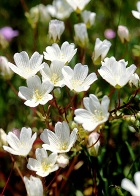Meadowfoam Seed Oil

Meadowfoam seed oil is one of the most stable lipids known, containing over 98% long chain fatty acids (C18, C20 and C22) and mixed tocopherols (Vitamin E).
Refractive Index: 1.470 @ 25° C.
Specific Gravity: 0.910 to 0.920 @ 20° C.
Appearance: light colored, odor free liquid
BioChemicals: Saturated fatty acids (typically 1%): palmitic (<1%), stearic (<0.5%)
Monounsaturated fatty acids (typically 77%): C16:1 palmitoleic (<0.5%), C18:1 oleic (0-4%), C20:1 ecosenoic (60-65%), C22:1 eruric (8-11%)
Polyunsaturated fatty acids (typically 22%): C18:2 linoleic (0-4), C18:3 α-linolenic (trace)
Other constituents: C22:1 δ-linolenic (2-4%), C22:2 (15-23%)
α-, β-, γ-tocopherols (0.07%)
Saponification Value: 169
CAS No: 153065-40-8
Meadowfoam is currently cultivated in Oregon and New Zealand.
The fruit of the plant is a nutlet and contains 20-30% oil, which is obtained by solvent extraction or cold pressing from the crushed seeds.
Most meadowfoam oil is produced by solvent extraction, which can remove some of the non-oil ingredients.
Cold Pressed oil is mechanically extracted and filtered with no further refining. It is deep red-orange in color, and contains more of the active non-oil materials such as tocopherol and phytosterols.
Cosmetic Uses
- as an emollient
- improve stability and shelf life when used with other oils
- skin moisturizer
- hair rejuvinating and adds shine
- anti-aging and wrinkle reduction
- blends well with other fixed oils
- lip and skin balms as a moisturizer and to add stability
In the late 1970's Meadowfoam seed oil was discovered by the Japanese cosmetics industry. As demand increased, a growers cooperative was formed, which eventually started a secondary production site in New Zealand.
In 2004 production of Cold Pressed oil was started from seed grown in New Zealand. In 2008 Meadowfoam CP was accepted for Ecocert certified cosmetics.![]()
Not assessed for safety in cosmetics by an industry panel.
The information provided on these pages is not a substitute for necessary medical care, nor intended as medical advice. Always keep carriers and bases tightly closed and in a cool, dark place, out of reach of children. If redness or irritation occurs when applied to the skin, stop using immediately and contact your health provider if necessary.![]()
all images and content copyright ©2000—2020 by suzumebachi design and samara botane





